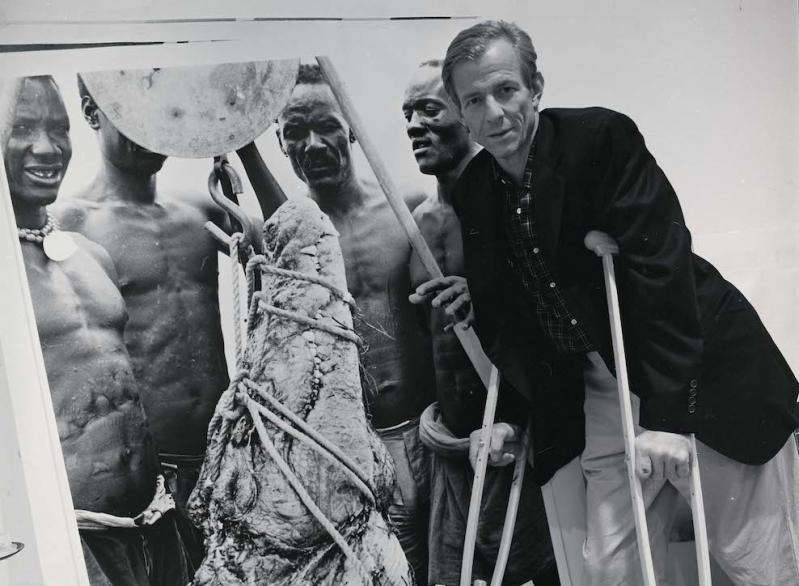Peter Beard, a photographer and artist known for his exotic and exuberant personal life, was found dead on Sunday after being missing since March 31. He was 82 and had dementia, and had experienced a stroke in recent years.
His disappearance prompted an extensive search of the bluffs and woods around his Montauk residence, first by family and neighbors, then police, park rangers, and other first responders.
Mr. Beard led a bon vivant’s life, carousing at exclusive clubs and parties around the world. Yet he always returned to his retreats in New York, including Montauk — where he moved a house to his property on Old Montauk Highway in 1973 — and Kenya, where some of his most iconic wildlife photography was taken.
After studying art history at Yale University, he traveled to Kenya and documented the deaths of thousands of elephants and other wildlife in Tsavo National Park. His photographs became the basis for a 1965 book, “The End of the Game,” which influenced a generation of artists as well as wildlife conservationists. His diaries and embellished photographic prints, filled with drawings, blood (from his own body and those of animals), and other materials, were considered works of art unto themselves.
His Kenyan property, Hog Ranch, bordered the coffee plantation once owned by Karen Blixen, who used the pen name Isak Dinesen to write “Out of Africa.”
After numerous scrapes with wildlife, in 1996 he was crushed by an elephant’s head after it gored his leg with its tusk. The incident left him with fractures in his pelvis and other serious injuries, causing massive internal bleeding. He almost died, but after a series of surgeries he eventually recovered, gaining back his eyesight and the use of his legs.
Mr. Beard was born in New York City on Jan. 22, 1938, into tobacco and railroad fortunes through his parents, Anson McCook Beard Jr. and Roseanne Hoar Beard. His family lived in Alabama, where his father was stationed with the Air Force, New York City, and Long Island. He attended the Buckley School and graduated from the Pomfret School before attending Yale, where he was a member of the Scroll and Key Society and studied with the artist Josef Albers and the art historian Vincent Scully.
He was notorious for attracting women wherever he went and was married three times. His first marriage, to Minnie Cushing Beard Coleman in 1967, was brief. Cheryl Tiegs, an early celebrity “supermodel,” was his wife from 1982 to 1986. In 1986, he married Nejma Khanum Beard, with whom he has a daughter, Zara Beard, who is 31. Both survive him, as do his brothers, Anson Beard Jr. and Samuel Beard, and a granddaughter.
According to a 2016 East magazine article, he first visited Montauk with Lee Radziwill in the early 1970s. The couple stayed at Andy Warhol and Paul Morrissey’s 5.6-acre estate, Eothen. During this time, they helped bring together Ms. Radziwill’s aunts, Big Edie and Little Edie Beale, and Albert Maysles, resulting in the documentary “Grey Gardens.”
Soon, Mr. Beard found his own property on the bluffs, once owned by Arthur Miller and Marilyn Monroe. He told East, “Instead of the African plains, I had the vastness of the ocean.”
The house became the site of Rolling Stones recordings, where their music competed with the nearby radar tower that “emitted this horrible series of noises every 45 seconds,” he recalled. The designer Halston, a fellow Studio 54 regular, was also a visitor. Neighbors such as Dick Cavett, Paul Simon, and Richard Avedon were his dinner guests.
In 1977, the windmill he had moved to his property from Ditch Plain burned down and took with it all of his early journals and a good deal of artwork. In 2016, Guild Hall mounted “Last Word From Paradise,” an exhibition that brought together his artwork inspired by the wildlife and native people of Africa and the cafe society and celebrities he hung out with in New York and Montauk.
Christina Strassfield, the director of Guild Hall’s museum and chief curator there, recalled that “It had been 15 years since his last museum exhibition, and he had tremendous energy and excitement when pointing out all the details in his work, remembering people, places, and the circumstances for each and every piece that was selected.” Still imbuing his activities with glamour, the opening reception was the largest to date at Guild Hall, she said. “Peter stayed and greeted every visitor with a smile and kind words.”
The Beard family released a statement expressing their heartbreak over the loss and their gratitude to East Hampton’s first responders and those who helped them in their search. “He lived life to the fullest; he squeezed every drop out of every day,” they said. “He was an intrepid explorer, unfailingly generous, charismatic, and discerning.”
“Always insatiably curious, he pursued his passions without restraints and perceived reality through a unique lens,” the statement continued. “His visual acuity and elemental understanding of the natural environment was fostered by his long stays in the bush and the ‘wild-deer-ness’ he loved and defended. He died where he lived: in nature.”

